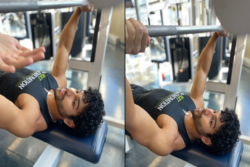The bench press (or chest press) is a widely practiced exercise in training facilities. This movement is often included in our workout routine, whether we’re individuals aiming to stay fit or powerlifting athletes. It’s important to note that the technique used in this exercise can vary based on our training experience and objectives.
A full-body exercise
Generally, the bench press primarily targets the pectoralis major, anterior deltoid, and triceps muscles. However, it’s an exercise that requires the activation of the entire body, particularly the muscles in the shoulder and scapular region. These areas play a crucial role in achieving optimal stability.
Stability is key to developing greater strength in the movement, which helps prevent potential injuries. Since the scapula is the only structure connecting our arm to the rest of our body, it’s important for it to be in an ideal position to efficiently transfer force between our chest, arm, and the bar.
The 7 steps to succeed in your bench press
1 – Choosing the grip width
The appropriate hand width is approximately 1.5 times the width of your shoulders. This measurement will help you determine where to place your hands. A wider grip is used by professional athletes as it allows for greater strength development, but be cautious as it increases the risk of injury.
Karl’s advice : Each individual is unique, so the notches on the bar are not universal reference points for everyone. Don’t always rely on them.
2 – Adjusting the bar position in the hand
The bar should be positioned at the base of your palm. Your thumb should wrap around the bar and not align with the other fingers.
Karl’s advice : The force vector of the bar should transfer towards our forearms and not exert pressure on our wrists. Having a good grip will prevent accidents and unnecessary injuries.
3 – Setting the arm angle with the body
Your arms should neither be too close nor too far from your body. A 45-degree angle is currently considered the optimal ratio for performing the movement.
Karl’s advice : The arm angle is crucial as it reduces the risk of shoulder impingement and allows for perpendicular forearms to the ground.
4 – Stabilizing the shoulder blades
The shoulder blades should be retracted (pulled inward) and depressed (positioned downward). Proper placement of the shoulder blades enables greater force development.
Karl’s advice : Be careful to retract the shoulder blades and then depress them. Many athletes rotate their shoulders backward, which increases the risk of injury.
5 – Stabilizing the buttocks and legs
As mentioned earlier, the bench press engages the entire body. Therefore, contract your glutes and anchor your feet firmly to the ground to achieve the best possible balance.
Karl’s advice : Having a stable lower body allows for optimal force transfer. If your feet are well-placed and your glutes are engaged, you will also have better control of the movement.
6 – Lower the bar under the chest
Once properly positioned, it’s time to lower the bar. But how far? You should stop just below your chest. This will allow your body to maintain the best angle and the most stable position.
Karl’s advice : A good landmark to aim for when lowering the bar is the lower part of our chest… the nipple!
7 – Apply force during the ascent
The long-awaited moment, the ascent. Gather all the strength you need and transfer it to your chest to push the bar. Remember to activate your triceps and deltoids to perform the movement safely.
Karl’s advice : A tip to apply force during the ascent is to imagine that you’re moving your body away from the bar (similar to what happens naturally in a push-up) instead of just pushing the bar away from your body.
The bench press is an exercise that is accessible to everyone and highly beneficial to include in your training routine. It is a functional movement that resembles various actions in our daily lives, such as pushing a door.
When starting with bench press, it’s important to gradually begin with light weights to focus on control, stability, and technique. By following the steps mentioned above, you should have no trouble mastering the exercise.
If you have any questions, pains, or need advice, discuss it with Karl-Gabriel Labissière during your appointment.
If you prefer visual guidance, we recommend watching this tutorial:


